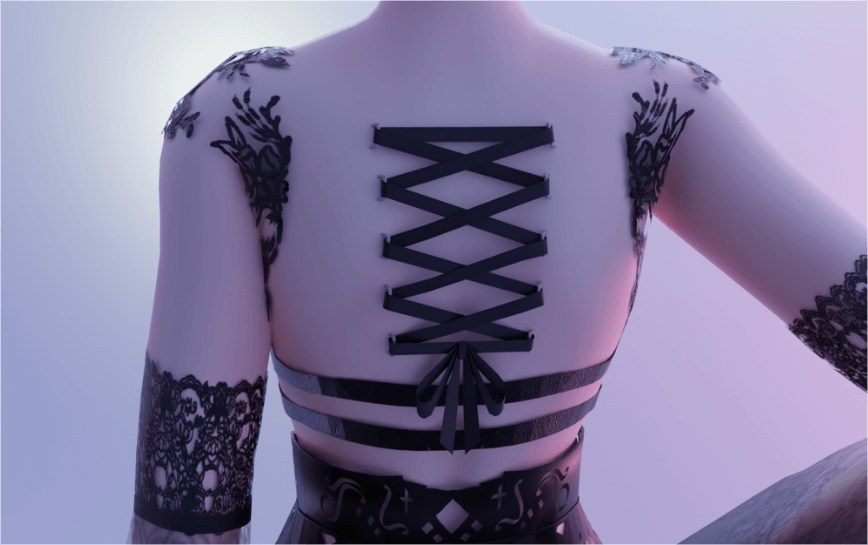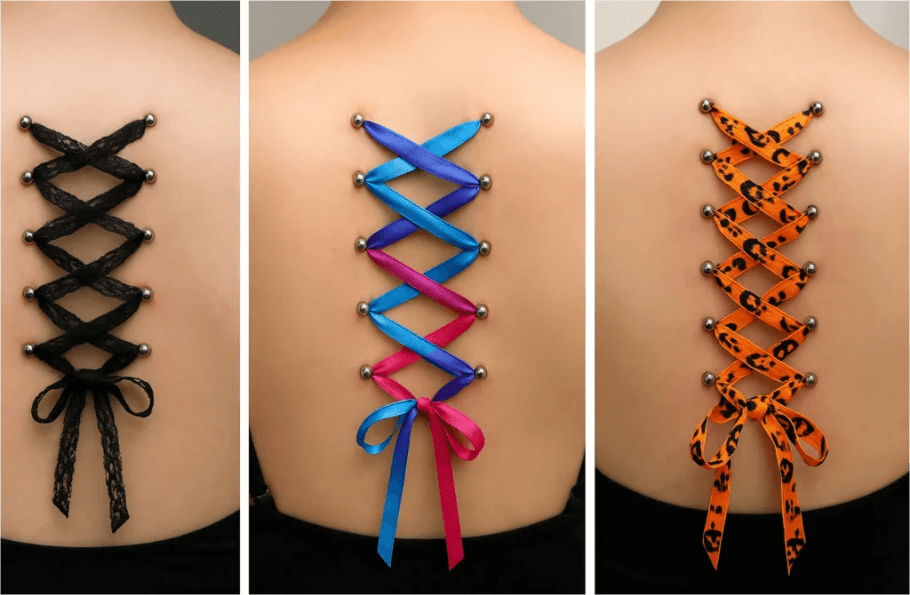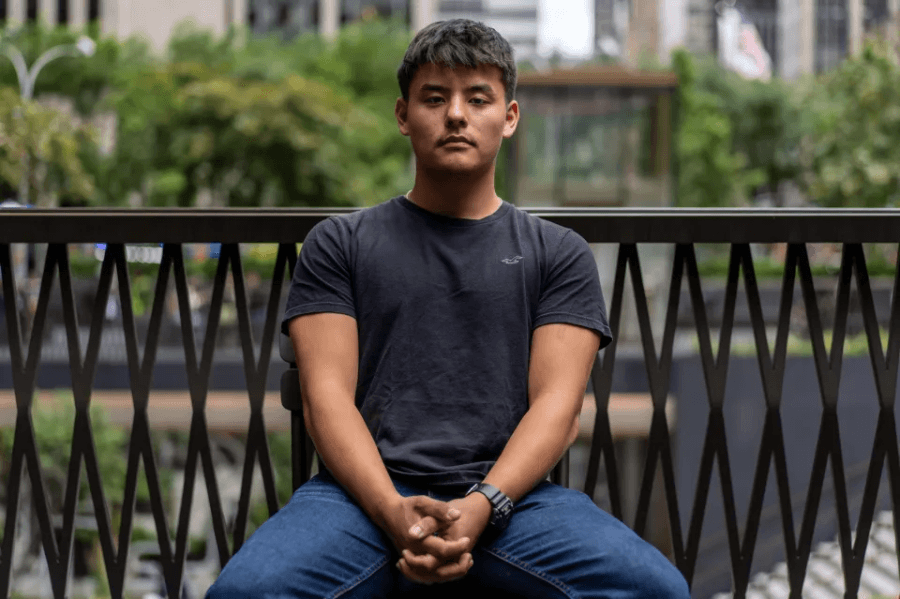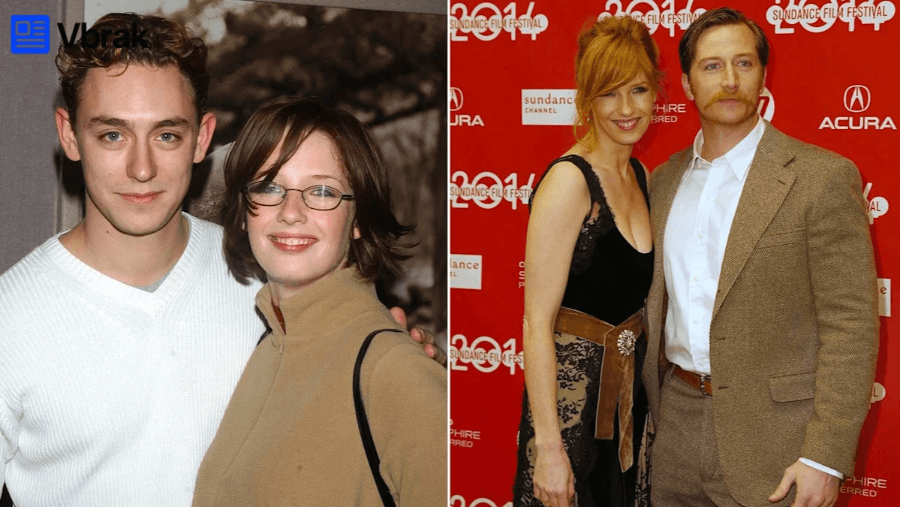📑Table of Contents:

Corset piercings are a unique and daring body modification that has gained popularity in the world of piercing culture. Unlike traditional piercings, corset piercings are a more elaborate form of body art that creates the illusion of a laced corset, often along the back, but sometimes along other parts of the body. It’s a form of self-expression and an eye-catching design that pushes the boundaries of what’s considered conventional in the world of body modifications.
If you’re considering getting a corset piercing or are just curious about this fascinating trend, this post will give you a deeper look into its origins, the process, healing considerations, and why it’s such a powerful form of body art.
What Is a Corset Piercing?
A corset piercing is a body piercing designed to resemble the lacing of a corset, often placed along the back. It typically consists of multiple piercings lined up in rows, with each hole being threaded with ribbon, lace, or sometimes chains, creating the appearance of a corset. Corset piercings are often temporary, especially when used for specific photoshoots, performances, or events, but some people choose to keep their corset piercings as permanent body modifications.
The visual impact of a corset piercing is stunning. It mimics the shape of a corset, drawing attention to the back and providing a striking, decorative element. The lacing can create dramatic curves, emphasizing the body’s natural lines in a way that can be both artistic and provocative.
The History and Origins of Corset Piercing
The corset piercing is a relatively recent addition to the world of body modifications. It first gained attention in the early 2000s within subcultures like Goth, punk, and alternative fashion communities. However, the origins of corset piercings are closely tied to the history of corsets themselves, which were a prominent feature of Western fashion from the 16th to the early 20th century.
The idea of a corset as body art resurfaced in the late 20th century as part of the body modification culture, where piercers began experimenting with lacing multiple piercings together in a way that mimics the traditional corset design. This modern approach to corset piercing became a symbol of strength, femininity, and individuality, and it was often featured in photoshoots and fashion editorials to create visually arresting images.
How is a Corset Piercing Done?
A corset piercing is not your typical piercing procedure. It requires careful planning and precision. Here’s a step-by-step look at how it is typically done:
1. Consultation and Planning
Before the procedure, you’ll meet with a professional piercer to discuss your design and ensure that the placement of the piercings will work with your body. Corset piercings often involve multiple holes, so it’s important that they are placed in a way that creates a harmonious, symmetrical design. The piercer will mark the spots for each piercing with a surgical marker, ensuring that the holes are spaced correctly.
2. Piercing Process
Corset piercings are done with a sterile needle, not a piercing gun. The piercer will first sterilize the area to prevent infection and ensure a clean environment. After the skin is cleaned, each hole is pierced individually. The number of piercings can vary depending on the design, but typically, corset piercings involve 8 to 12 piercings placed along the back or wherever the corset effect is desired.
3. Lacing the Piercings
Once the piercings are complete, the piercer will thread ribbon, lace, or chain through the holes to create the corset effect. The material used for lacing is often chosen based on the aesthetic desired. The lacing is carefully tied to ensure it stays in place and provides the desired look.
4. Aftercare and Healing
Corset piercings require a unique approach to aftercare. Since these piercings are often temporary, many people choose to remove the lacing after a short period, while some may decide to keep the piercings in place longer. Regular cleaning with saline solution and avoiding excessive movement or pressure on the pierced area are essential for preventing infection.
Corset Piercing Placement and Design
Corset piercings are most commonly done along the back and spine, though they can be placed on other areas of the body as well. The most popular placements include:
1. Back Corset Piercing
The classic location for a corset piercing is along the back, typically following the spine. This placement can create a stunning visual effect, especially when paired with a flowing garment that draws attention to the lacing.
2. Side Corset Piercing
Corset piercings are sometimes placed on the sides of the torso, either under the ribcage or near the waist. This design is often more subtle but still offers the dramatic effect of the laced appearance. Side corset piercings are perfect for those who want a more discreet version of the traditional back design.
3. Chest or Neck Corset Piercing
Corset piercings are also done along the chest or neck area, creating a bold and daring look. These placements are less common but make a powerful fashion statement. It’s important to note that these piercings may have a longer healing time due to their location on the body, which requires extra care.
Corset Piercing Healing and Aftercare
Healing corset piercings can be tricky, especially since they are typically clustered together. Aftercare is crucial to avoid complications such as infection or migration of the piercings. Here are some key tips to follow for proper healing:
1. Cleanliness Is Key
Since corset piercings are typically placed along the back, it’s essential to keep the area clean and free from bacteria. Clean the piercings with saline solution or a non-alcoholic piercing cleaner twice a day. Avoid harsh chemicals that could irritate the skin or piercings.
2. Avoid Tight Clothing
For the first few weeks, avoid tight or restrictive clothing that could rub against the piercings. Loose, breathable fabrics are best during the healing process.
3. Watch for Signs of Infection
If you notice increased redness, swelling, pus, or excessive pain around the piercings, these may be signs of infection. If you suspect infection, it’s best to consult your piercer or a healthcare professional for advice.
Why Get a Corset Piercing?
Corset piercings offer a combination of beauty, daring fashion, and personal expression. Here are a few reasons why people choose to get corset piercings:
1. Aesthetic Appeal
The visual impact of corset piercings is undeniable. The laced-up effect creates a dramatic, elegant look that can be paired with different types of clothing. Whether you want to draw attention to your back or create a unique design, corset piercings offer a bold, creative aesthetic.
2. Temporary or Permanent
Corset piercings can be either temporary or permanent, depending on your preference. Some people choose to have the piercings done for special events or photoshoots, while others decide to keep them long-term. The flexibility in how long the piercing stays in place is one of the reasons why people choose this form of body modification.
3. Symbolism and Personal Expression
For many, corset piercings are a form of self-expression. They may symbolize strength, confidence, or a love for alternative fashion. Whether you’re making a statement or simply want something unique, corset piercings offer an opportunity for personal empowerment.

Conclusion: Is a Corset Piercing Right for You?
Corset piercings are an extraordinary form of body art that merges fashion, body modification, and personal expression. Whether you’re drawn to their aesthetic, their symbolic meaning, or just looking to try something bold and unique, corset piercings offer a stunning and unforgettable way to express yourself. However, they do require a commitment to proper care, as well as an understanding of the risks involved.
Before you decide to get a corset piercing, it’s essential to consult with a professional piercer and understand the aftercare requirements. With the right approach, corset piercings can be a striking and empowering addition to your body modification journey.





